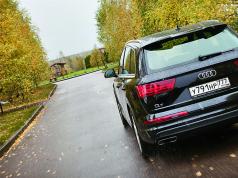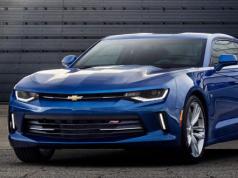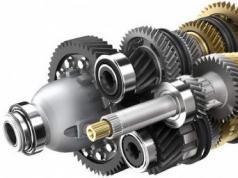For this legendary sedan, produced by Volkswagen, which at all times enjoyed an amazing steady demand and wild popularity, and now its own niche has been prepared. To assemble the Volkswagen Jetta, two enterprises work, one of which is located in Mexico, and the second in Russia in Nizhny Novgorod.
The Mexican plant produces cars for the American and European markets, and the plant in Nizhny Novgorod works for the CIS market.
Plant in Nizhny Novgorod
This enterprise is one of the youngest in the structure not only of the Volkswagen concern, but also among the factories of the Volkswagen Group Rus company. Full cycle production started at the end of 2012. The production capacity of the plant is designed for the production of up to 132 thousand cars, taking into account the fact that production has been mastered in three different models of Volkswagen and Skoda.
The Jetta produced at the plant has undergone a certain adaptation to operation on the roads of Russia and in difficult climatic conditions. The ground clearance was increased to 160 mm, and the suspension was specially made harsh, taking into account not the most even roads. The suspension was additionally reinforced, in particular, more powerful shock absorbers and anti-roll bars were installed.
Among the few flaws that were discovered at the stage of purchasing a car, and during the first operating experience, the following can be distinguished:
- Use of defective rubber bands in the rear door openings (delamination, uneven trimming, mechanical damage). Easily removed under warranty.
- With the exception of the soundproofing of the engine compartment, all other areas should be additionally reinforced (wheel arches, doorways, luggage compartment).
- When operating in winter conditions, there are problems in closing the trunk lock. Therefore, it is advisable to process it and prevent the accumulation of snow and moisture in the mechanism.
- Rigid suspension and poor quality roads transmit strong vibration to the front console parts, resulting in squeaks and rattles.
As unpleasant features of a car, there is a high cost of some options, therefore, it is better to install some auto add-ons, navigation, multimedia system, parking sensors on your own.
Factory in Mexico
Mexican cars can be found both almost new and used. It should be borne in mind that the delivery of a new car is quite expensive.
The following shortcomings are noted on the overseas Volkswagen Jetta:
- Poor quality center console trim panels and door inserts.
- Insufficient noise insulation of wheel arches and doorways. Therefore, many are finalizing this gap on their own.
- The head unit and speakers are of poor quality, which not only does not provide the proper sound, but also leads to frequent breakdowns.
- Low quality paintwork, which is prone to minor damage (chips and scratches).
In recent years, Volkswagen has positioned the VW Jetta as the "people's" car for Americans and a vehicle that is gaining popularity among Europeans. For the Russian consumer, the Volkswagen Jetta is more of a fashion statement than a necessity. However, despite this, most domestic car owners are wondering where the Volkswagen Jetta model is assembled.
According to official sources, the Jetta is being assembled in Mexico. The fact is that the main sales market is located here and, for obvious reasons, the cars that are assembled for the United States are significantly different from those that are supplied overseas. The Germans are changing their ideology that the model should have the same performance, regardless of who will be its final consumer. Hence the difference in cost and trim levels between the American and European versions of the Volkswagen Jetta model.
The main differences between the "Russian" VW Jetta
Until recently, in order to answer the question of where the Volkswagen Jetta is assembled, it was only necessary to say about the plant in Germany. However, times are changing, and today the Jetta version for the Russian market is assembled at two factories: in Kaluga and in Mexico. The Mexican assembly of the Volkswagen Jetta is intended for the European and US markets. As a rule, it is a little more expensive than the Kaluga assembly, but the "European" has no adaptation for our roads and "Russian driving". Therefore, domestic car owners should not bother with the idea of purchasing a purely German assembly of the Jetta.
If we compare the build quality of the Volkswagen Jetta, which is sold in Russia, then it has a multi-link rear suspension, which is taken from the Volkswagen Golf. In the American version of the car, the suspension is a simplified version of the twisting beam. If we talk about the Volkswagen Jetta model, which is intended for the European market, then here two types of CAN buses are installed for the exchange of data between electronic components. In the American version, there is only one, however, the very quality of the models is very high.
In addition, the bodies of these versions are also designed to meet the different requirements for passive safety. The Russian version uses soft plastic, the "European" has a hard finish in the cabin. Also, a domestic buyer can create a car assembly "by himself" by choosing optional equipment from the list. "Civilian" motorists can purchase only fixed configurations.
It is also worth saying that in addition to the Volkswagen Jetta of the Mexican, Kaluga, German assembly, there is also a Chinese version. But, as practice shows, this is generally a kind of mix. It is only outwardly related to our and European assembly, otherwise it is a completely different car, since in the Middle Kingdom, as in India, such cars are driven exclusively accompanied by a personal chauffeur. That is why, for consumers of the East, such options are offered to order, such as rear climate control, a control system for rear passengers, with which you can control the front passenger seat, audio system and navigation.

Stages of production of the "Russian" car VW Jetta
If we talk about the Kaluga assembly of the Volkswagen Jetta, then it and its quality are fundamentally no different from the Mexican one. The fact is that the Volkswagen Group company carefully monitors the quality of the cars produced at its factories, regardless of their geographical location. The plant in Kaluga is equipped with all the necessary technological innovations and innovative equipment.
The production line, where the Volkswagen Jetta is produced, has its own welding workshop, in which the basic structure is created, then it is sent to the paint shop, where, according to the proprietary recipe, the structure is painted in the required color and then it is sent to the drying chamber. Next, the car is assembled directly, which consists of several stages:
- At the first stage of the assembly, the interior is mounted, where the passenger seats, body doors, and interior trim are installed.
- At the next stage, the car is equipped with a power unit, transmission and the entire chassis. It is worth mentioning that all parts, load-bearing body elements and power plants are brought to the plant directly from Germany, so you should not worry about their quality, reliable and operational durability.
- Further, the already assembled Volkswagen Jetta vehicle is moved to the next production site - the so-called sump. All the time the car is here, production supervisors examine it for any defects and shortcomings. If they identify deficiencies, then the production unit is immediately sent either to the appropriate workshop for revision or to scrap.
- After passing a thorough quality control and technical condition, a fully finished and complete car is sent to dealerships for further sale.
Thus, today, regardless of where the Volkswagen Jetta car is assembled, it remains an example of German quality and European excellence in everything. In other words, if domestic car owners choose this particular car model for themselves, then as a result they will certainly enjoy not only the comfort and perfectly matched interior components, as well as optional equipment, but will certainly appreciate the reliability and adaptive qualities of the VW Jetta.
The German Volkswagen is known not only for its quality and attention to detail, but also for the beauty created by designers and embodied in the company's cars. Jetta is no exception. A car that has been created for more than 40 years, has gone through many transitions from generation to generation, improves its driving performance, its appearance with each of these generations can rightfully be considered one of the best creations of the concern.
Place of assembly
The official production and sale of the Jetta on the territory of the Russian Federation began only in 2008, together with the opening of the conveyor for the production of the fifth generation of the car in Kaluga. The car was produced both with gasoline engines (with a volume of 1.4 to 2.5 liters) and diesel (with a volume of two liters). Gearbox choices ranged from five and six-speed manual gearboxes to six-speed automatic and six- and seven-speed semi-automatic transmissions. The Euro NCAP test showed a maximum five safety stars for the Jetta.
The sixth generation has also recently been produced in Kaluga. It makes little sense to paint the chassis, since it has hardly changed since the fifth generation.
Build quality
It is indicative that the owners do not have any objective quibbles about the assembly of the car - even the Russian assembly deserves praise from satisfied buyers. The plastic of the interior does not begin to creak even after prolonged operation, the car is not as susceptible to corrosion as some representatives of this segment, wide gaps and other defects in the body welding in some batches were also not noticed by the owners.
However, if we take into account that we live in Russia and we have to deal with Russian roads, then one serious drawback comes to light, which should have been worked with at the Kaluga auto plant - the landing at the car is quite low. Suspension redesign would not have prevented this car from getting more ideal status in its segment.
(No ratings yet)
”Was launched in 1979 with a focus primarily on the American market. The front-wheel drive car had versions with two- and four-door bodies and was equipped with gasoline engines with a volume of 1.1 to 1.8 liters (49-110 hp) and diesel engines with a volume of 1.6 liters: atmospheric (53 hp) and turbocharged (69 hp) For a surcharge, buyers were offered a three-stage "automatic".
2nd generation, 1984

The second-generation Jetta, which debuted in 1984, became larger and got richer equipment. In addition to Germany, the car was assembled in Bosnia, Mexico, South Africa, Nigeria, and the USA. The range of engines was very wide: gasoline carburetor and injection engines with a volume of 1.3–2.0 liters (54–137 hp), as well as 1.6 diesel engines (54–79 hp)

In 1991, the production of the Jetta began in China, at the FAW-Volkswagen joint venture. The design of the car was updated several times, the equipment of the car was gradually improved. The production of the model ended only in 2013.

3rd generation, 1992

In 1992, sales of the third generation sedan started. Cars for European countries, produced in Germany, received a name, in the American market the car retained the name Jetta, they were made at a plant in Mexico. The two-door version disappeared from the lineup, and a 2.8 VR6 gasoline engine appeared in the range of power units, developing 174 hp. with., and turbodiesels of the TDI family with a volume of 1.9 liters.
4th generation, 1998

The fourth generation cars again had different names: in Europe it was, but the Jetta name was retained for the American market. Cars were produced from 1998 to 2005 in Germany, Slovakia, Mexico, South Africa, Poland, and even Ukraine. They are still made in China. In addition to the sedan, buyers were offered a Volkswagen Jetta with a station wagon. The base engine was a 1.4-liter with 74 hp. with., and the most powerful - 2.8 VR6, developing 204 liters. from.
5th generation, 2005

The fifth generation of the sedan once again received the Jetta name in the European market, as in most other countries. Only in some countries of Latin America was the model called Bora or Vento, and in China it was known as Sagitar. The main enterprise producing the Jetta was the plant in Puebla (Mexico), but the assembly was also carried out in South Africa, China (under the name), India, Russia (the plant in Kaluga began to make this model in 2008), in Ukraine.
The Volkswagen Jetta for the Russian market was equipped with aspirated engines 1.6 (102 hp) and 2.0 FSI (150 hp), a turbocharged 1.4 TSI engine (122 hp), as well as 1.9 and 2 liter turbo diesels with a capacity of 105 and 140 l. from. respectively. In other countries, versions 1.6 FSI (116 HP), 1.4 TSI (140-170 HP), 2.0 TFSI (200 HP) and modifications with a five-cylinder 2.5-liter engine developing 150-170 l. from. The turbodiesels had a volume of 1.6-2.0 liters and a capacity of 136-170 liters. from. Some versions were equipped with optional "automatic machines", and some - with DSG preselective robotic gearboxes.
In 2007, a version with a Jetta Variant station wagon appeared in the lineup (in the American market - Jetta Sportwagen). As a result of the 2010 restyling, the station wagon received a new appearance in the style of “
A lot of cars are assembled in Russia, and lately there are more and more of them. Admirers of some brands fundamentally refuse Russian-made cars. Say, ours will do everything worse and not as reliably as foreigners. Of course, it has always been assumed that the assembly of a car affects the performance of a car. This concept can be accepted, but it is better not to apply it to machines. After all, if the model is assembled in the country in which it will be sold, then it will be better adapted for local roads. Who knows the flaws of autobahns or bumps better than Russian engineers ?!
Today I would like to talk about the Volkswagen Jetta. This machine is becoming more and more popular every year. Let's look at how she won such confidence, what kind of appearance they gave to the model and where the Volkswagen Jetta is assembled. In general, do our engineers produce the German jett model on a par with the European ones, or is it worth believing the popular principles.
Countries where Volkswagen Jetta is assembled
The new version of the Volkswagen Jetta is being created in only two countries. Both modifications of the model are available to our consumer. They are collected in Russia and Mexico.
Mexican examples are being prepared for the European and American markets. Compared to our assembly, they are somewhat more expensive. But our consumer should not pay attention to such standards. After all, Russian roads and European autobahns are heaven and earth.
When asked who collects Volkswagen Jetta for our market, the answer is very simple. It is made in Kaluga. We want to say right away that only cars of this assembly are best adapted to our roads and the driving of Russian drivers.

Judging by the test drives, the Mexican assembly does not differ at all from the Russian one. Both enterprises are equipped with the latest technology. All metal parts are brought from Germany, and in the car there are more than 70% of them.
Representatives of Volkswagen in the Russian Federation have set a price for the basic configuration of the car at 648 thousand rubles. It comes with a 1.6-liter 105 horsepower engine.
Our engineers have come up with a Conceptline package specifically for the Russian market. The transmission here can be of two options - a mechanical five-speed or six-speed automatic. This is fully consistent with the European version of the car. Also, for Russia, the car is equipped with a complete safety kit, power steering, infotainment system, air conditioning and an electric drive.

For the Russian market, a special winter package of the Volkswagen Jetta model was invented. It includes heated mirrors, washer nozzles, a spare wheel and discs marked 6J * 15 with decorative caps. The buyer can choose the color scheme of the car from eight options. The most popular of these are Tornado red, Storm blue and Topaz brown.
The second package of options produced by Russian engineers is the Comfort package. It includes all of the above options, but with additional heated seats.

Also, the Technic version is available to our customer. It allows you to install anti-towing and anti-theft systems with optional immobilizer, CD / MP3 player and USB cables for iPod.
The cost of Russian complete sets of Volkswagen Jetta
Previously, the Trendline variant was the basic configuration. Due to the Russian assembly, it fell in price and costs 688 thousand rubles.
The Conceptline modification will cost its customers from 733,000 rubles, and the Highline is the most expensive. Russian engineers equipped it with a 1.4-liter diesel engine. It produces 122 horsepower, which is quite enough for our roads.
As you can see, our masters did their best. They collect cars as well as Mexicans. Therefore, when buying a model, do not worry about its durability and quality.







